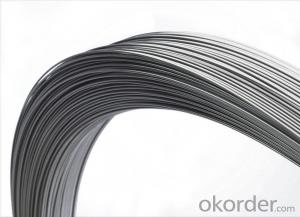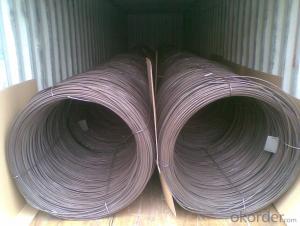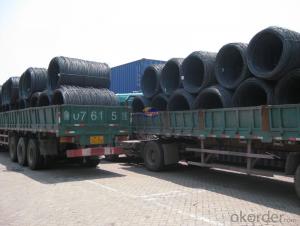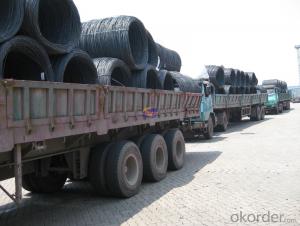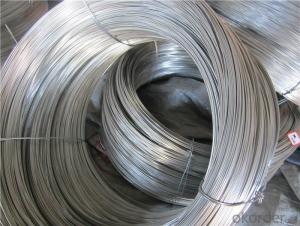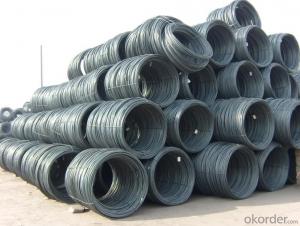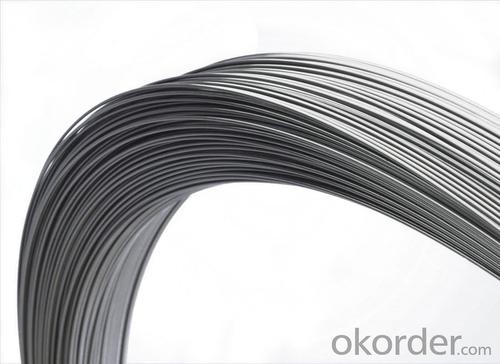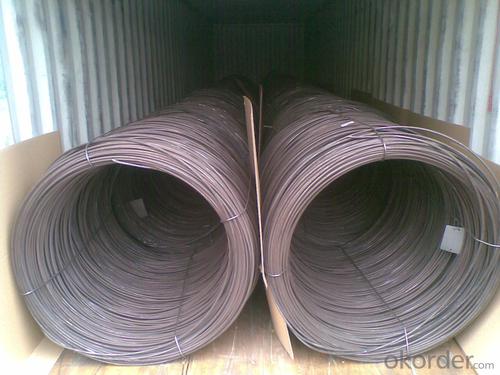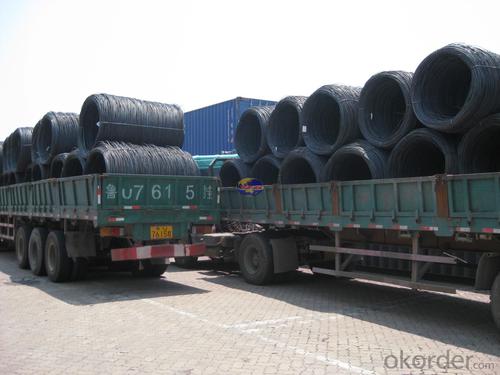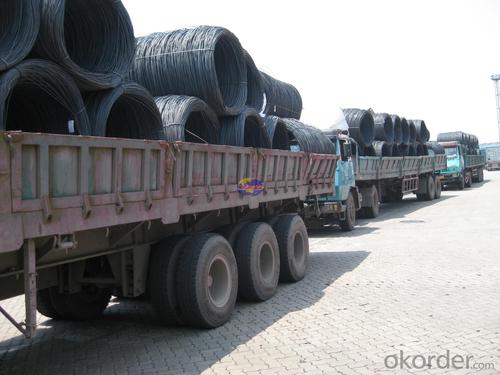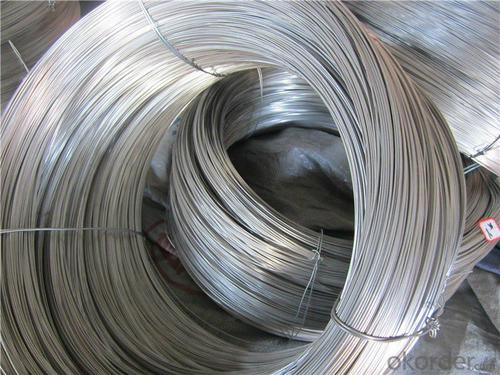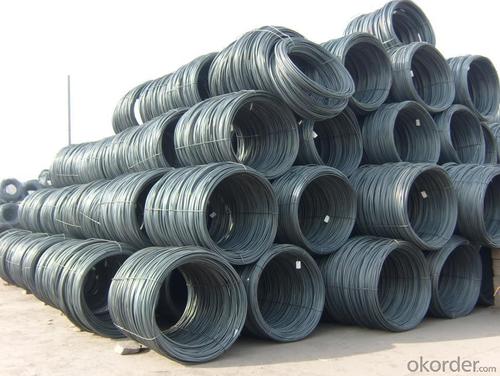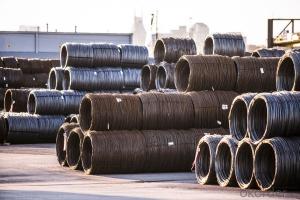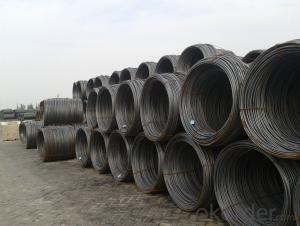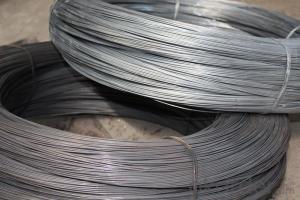SAE1006Cr Carbon Steel Wire Rod 16.5mm for Welding
- Loading Port:
- Shanghai
- Payment Terms:
- TT OR LC
- Min Order Qty:
- 100 m.t
- Supply Capability:
- 30000 m.t/month
OKorder Service Pledge
OKorder Financial Service
You Might Also Like
Specification
Description of SAE1006Cr Carbon Steel Wire Rod 16.5mm for Welding:
OKorder is offering Color Coated Steel Coil Prepainted Steel Coil at great prices with worldwide shipping. Our supplier is a world-class manufacturer of steel, with our products utilized the world over. OKorder annually supplies products to European, North American and Asian markets. We provide quotations within 24 hours of receiving an inquiry and guarantee competitive prices.
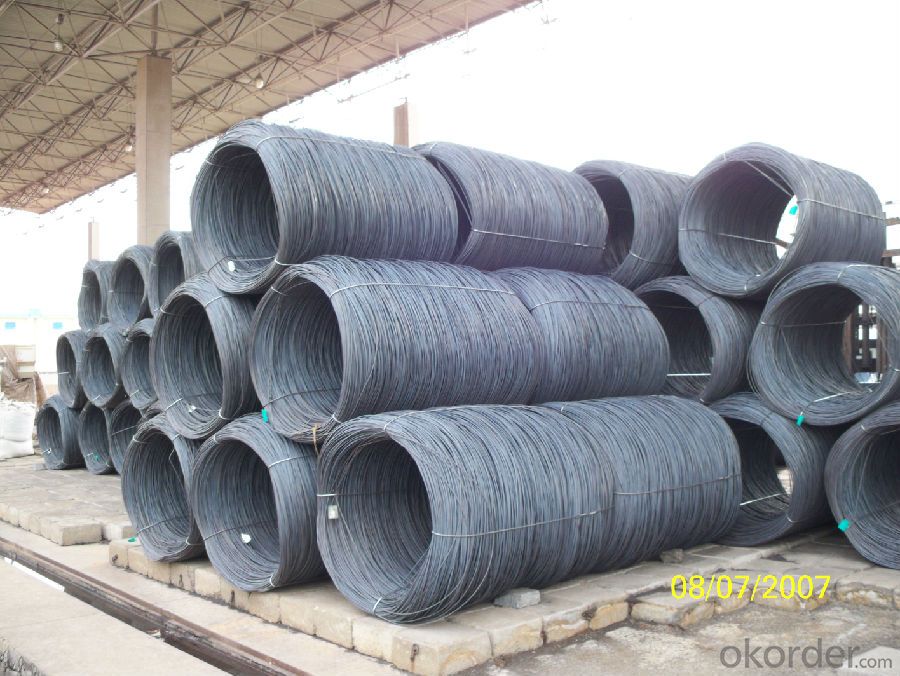
Applications of SAE1006Cr Carbon Steel Wire Rod 16.5mm for Welding:
Color Coated Steel Coil Prepainted Steel Coil are ideal for structural applications and are widely used in the construction of buildings and bridges, and the manufacturing, petrochemical, and transportation industries.
Main Product Features of SAE1006Cr Carbon Steel Wire Rod 16.5mm for Welding:
· Premium quality
· Prompt delivery & seaworthy packing (30 days after receiving deposit)
· Corrosion resistance
· Can be recycled and reused
· Mill test certification
· Professional Service
· Competitive pricing
Specifications of SAE1006Cr Carbon Steel Wire Rod 16.5mm for Welding:
1, Introduction: Color coated steel coils(sheets), i. E. PPGI, also called prepainted steel coils(sheets), are made of galvanized steel coils(sheets) with polymer coatings as surface. It's a new enclosure material and building board with characteristics of light-weighted, heat preserved&insulated, easily installed with bright colors.
2, Production Process: Pretreatment(Degreasing)_Drying_Chromating_Paint Basic Oil_Cooling_Drying_Color Coating_Cooling_Film-covering_Rolling Up
3, Characteristics:
Good at corrosion resistence. Besides zinc coating of the basic plate of galvanized steel sheet, the color coating as the surface has double lifetime to ensure better anticorrosion effect.
With excellent cold bending molded manufacturablity, PPGI products can be processed or directly used as final product. As being light-weighted and conveniently transported, they're widly used to replace wood to save energy.
4.There're thousands of colors can be chosen as per different application. Any color plays well in decoration.
No pollution with high recycling rate, PPGI coils and sheets are strongly recommended as enviroment-friendly products by the government.
5, eye bands and 4 circumferential bands in steel, galvanized metal fluted rings on inner and outer edges, galvanized.
| commodity | SAE1006Cr Carbon Steel Wire Rod 16.5mm for Welding |
| Techinical Standard: | JIS G3302-1998, EN10142/10137, ASTM A755 |
| grade | Q195,Q215,Q235,SAE1006,SAE1008 SAE1006Cr |
| Types: | Mesh welding |
| Base metal | galvanized, galvalume, cold rolled steel |
| Thickness | 0.14-1.0mm(0.16-0.8mm is the most advantage thickness) |
| Width | 610/724/820/914/1000/1200/1219/1220/1250mm |
| Type of coating: | PE, SMP, PVDF |
| Zinc coating | Z60-150g/m2 or AZ40-100g/m2 |
| Top painting: | 5 mic. Primer + 15 mc. R. M. P. |
| Back painting: | 5-7 mic. EP |
| Color: | According to RAL standard |
| ID coil | 508mm610mm |
| Coil weight: | 2--3MT |
| Package: | Properly packed for ocean freight exportation in 20'containers |
| Application: | Industrial panels, roofing and siding for painting/automobile |
| Price terms | FOB, CFR, CIF |
| Payment terms | 20%TT in advance+80% TT or irrevocable 80%L/C at sight |
| delivery time | 25 days after recepit of 20% TT |
| Remarks | Insurance is all risks |
| MTC 3.1 will be handed on with shipping documents | |
| We accept SGS certificatation test |
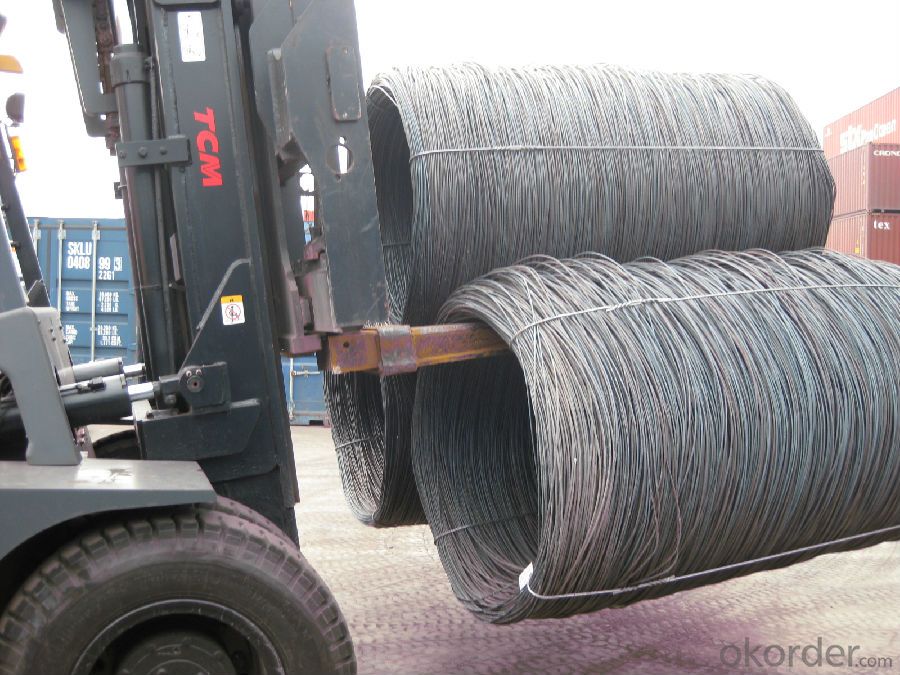
FAQ of SAE1006Cr Carbon Steel Wire Rod 16.5mm for Welding:
Q1: Why buy Materials & Equipment from OKorder.com?
A1: All products offered byOKorder.com are carefully selected from China's most reliable manufacturing enterprises. Through its ISO certifications, OKorder.com adheres to the highest standards and a commitment to supply chain safety and customer satisfaction.
Q2: How do we guarantee the quality of our products?
A2: We have established an advanced quality management system which conducts strict quality tests at every step, from raw materials to the final product. At the same time, we provide extensive follow-up service assurances as required.
Q3: How soon can we receive the product after purchase?
A3: Within three days of placing an order, we will begin production. The specific shipping date is dependent upon international and government factors, but is typically 7 to 10 workdays.
Q4: What makes stainless steel stainless?
A4: Stainless steel must contain at least 10.5 % chromium. It is this element that reacts with the oxygen in the air to form a complex chrome-oxide surface layer that is invisible but strong enough to prevent further oxygen from "staining" (rusting) the surface. Higher levels of chromium and the addition of other alloying elements such as nickel and molybdenum enhance this surface layer and improve the corrosion resistance of the stainless material.
Q5: Can stainless steel rust?
A5: Stainless does not "rust" as you think of regular steel rusting with a red oxide on the surface that flakes off. If you see red rust it is probably due to some iron particles that have contaminated the surface of the stainless steel and it is these iron particles that are rusting. Look at the source of the rusting and see if you can remove it from the surface.
- Q: Can steel wire rod be used for welding applications?
- Indeed, welding applications can incorporate steel wire rod. As a filler material, steel wire rods are frequently employed in welding procedures. Generally composed of low carbon steel, they come in diverse sizes and grades to cater to distinct welding necessities. Steel wire rods can be put to use in various welding applications, including arc welding, MIG welding, TIG welding, and spot welding. When utilized correctly, they yield a sturdy and dependable weld. Nonetheless, it is crucial to meticulously choose the suitable wire rod, taking into account the metal type being welded and the specific welding technique employed.
- Q: What are the factors that affect the pricing of steel wire rod?
- The pricing of steel wire rod can be influenced by multiple factors. Let's consider some of these factors: 1. Raw material costs: The price of the raw materials used in steel wire rod production is a significant factor. This includes the cost of iron ore, coal, and other minerals required in the steelmaking process. Changes in these raw material prices can directly impact the pricing of steel wire rod. 2. Supply and demand: The demand for steel wire rod plays a crucial role in determining its price. When demand is high, prices tend to rise, whereas low demand can lead to price reductions. Similarly, the supply of steel wire rod, influenced by factors like global production capacity, can affect its pricing. 3. Energy expenses: Steel production necessitates a substantial amount of energy. Consequently, fluctuations in energy prices, such as electricity and fuel costs, can impact the overall production costs of steel wire rod and, subsequently, its pricing. 4. Production and labor costs: Various factors, including labor costs, machinery maintenance, transportation, and overhead expenses, affect the cost of producing steel wire rod. These costs can vary from region to region and country to country, thereby impacting the final pricing of the product. 5. Government regulations and trade policies: Government regulations, taxes, tariffs, and trade policies can significantly impact the pricing of steel wire rod. Trade barriers and import/export duties imposed by governments can affect the cost of importing or exporting steel wire rod, ultimately influencing its market price. 6. Market competition: The level of competition within the steel wire rod market can also influence its pricing. When there is a high number of suppliers or alternative options available, prices tend to be more competitive. Conversely, limited competition can lead to higher prices. It is important to note that these factors are interconnected and subject to fluctuations over time. As a result, the pricing of steel wire rod is highly dynamic and influenced by various market forces and external factors.
- Q: What are the common industry best practices for steel wire rod suppliers?
- Some common industry best practices for steel wire rod suppliers include ensuring quality control throughout the manufacturing process, adhering to international standards and certifications, maintaining efficient production and delivery systems, providing excellent customer service, and continuously improving product offerings and technology.
- Q: What are the common inspection methods for steel wire rod?
- The common inspection methods for steel wire rod include visual inspection, dimensional measurement, chemical composition analysis, mechanical testing, and surface quality evaluation.
- Q: What are the different toughness testing methods for steel wire rod?
- To assess the strength and durability of steel wire rods, there exist various toughness testing methods. Some commonly utilized techniques include: 1. The Charpy Impact Test: This method entails striking a notched specimen with a pendulum hammer and measuring the energy absorbed during fracture. It offers insights into the material's resistance to impact loading and aids in evaluating the ductile-to-brittle transition temperature. 2. The Izod Impact Test: Similar to the Charpy test, this approach measures the energy absorbed by a notched specimen when struck by a swinging pendulum. It proves particularly valuable when assessing the toughness of materials with low impact resistance. 3. Tensile Testing: This method involves subjecting a wire rod to a gradually increasing tensile force until it fractures. By measuring the maximum applied force and the elongation at fracture, one can determine the steel's tensile strength and ductility. While not a direct measure of toughness, tensile testing provides crucial insights into the material's mechanical properties. 4. The Bend Test: In this test, a steel wire rod is bent to a specified angle and inspected for any signs of cracking or fracture. The ability of the material to endure bending without failure serves as an indicator of its toughness and ductility. 5. Hardness Testing: Hardness tests, such as the Rockwell or Brinell test, gauge a material's resistance to indentation. Although hardness does not directly measure toughness, it can offer indications of the material's strength and its ability to resist deformation. 6. Fracture Toughness Testing: This method involves measuring the critical stress intensity factor (KIC) or fracture toughness of a material. It provides valuable information about how the material will behave under stress, including its resistance to crack propagation. In summary, these toughness testing methods contribute to the evaluation of steel wire rods' performance and suitability for diverse applications, including construction, manufacturing, and engineering. The choice of testing method depends on the specific requirements and characteristics of the material under assessment.
- Q: How is the corrosion resistance of steel wire rod determined?
- The determination of the corrosion resistance of steel wire rod involves various methods and tests. One commonly employed approach is the salt spray test, also known as the ASTM B117 test. During this test, the steel wire rod undergoes exposure to a controlled environment containing salt mist or fog for a specified duration. Subsequently, the wire rod is inspected for indications of corrosion, such as rust or discoloration. Another technique employed to evaluate corrosion resistance is the pitting corrosion test. This test entails exposing the steel wire rod to a corrosive solution, such as a chloride solution, and monitoring the development of pits or localized corrosion. The severity and extent of pitting corrosion provide valuable insights into the wire rod's resistance to corrosive environments. Moreover, electrochemical methods like the polarization resistance test and electrochemical impedance spectroscopy can be utilized to assess the corrosion resistance of steel wire rod. These tests involve measuring the electrical response of the wire rod when subjected to an applied voltage or current. By analyzing the resulting data, corrosion rates and potential susceptibility to corrosion can be determined. Various factors also influence the corrosion resistance of steel wire rod, including the composition of the steel alloy, the presence of protective coatings or surface treatments, and environmental conditions such as temperature and humidity. These factors are often considered in conjunction with the aforementioned tests to provide a comprehensive evaluation of the wire rod's corrosion resistance.
- Q: How is steel wire rod used in the manufacturing of cables and wires?
- Steel wire rod is an essential raw material used in the manufacturing of cables and wires. It serves as the core material that provides strength, durability, and conductivity to the final product. The steel wire rod is first drawn into thinner wires through a process called wire drawing. These drawn wires are then used to create various types of cables and wires by either wrapping them around a central conductor or braiding them together. The high tensile strength and flexibility of steel wire rod make it ideal for transmitting electricity, telecommunications signals, and supporting structures in the cables and wires industry.
- Q: What are the safety precautions for handling steel wire rod?
- Some safety precautions for handling steel wire rod include wearing appropriate personal protective equipment such as gloves, safety glasses, and steel-toed boots. It is important to handle the rods with care to avoid injuries, such as cuts or punctures. Additionally, workers should be trained on proper lifting techniques to prevent strains or back injuries. Regular inspections of the rods and equipment should also be conducted to identify any potential hazards or defects.
- Q: What are the safety considerations for handling steel wire rod?
- Some safety considerations for handling steel wire rod include wearing appropriate personal protective equipment such as gloves, safety glasses, and steel-toed boots to protect against potential injuries. It is also important to ensure proper lifting techniques are used to prevent strains or back injuries. Additionally, workers should be trained on the proper handling and storage procedures to avoid accidents caused by improper stacking or movement of the rods. Regular inspections of the wire rods and equipment should be conducted to identify any potential hazards or defects that could compromise safety.
- Q: How is steel wire rod used in the production of mesh fencing?
- Mesh fencing production relies heavily on steel wire rod, which serves as the primary material for creating the individual wires that are woven or welded together to form the desired mesh pattern. To initiate the manufacturing process, the steel wire rod undergoes a series of mechanical operations, including drawing and annealing, in order to enhance its strength and flexibility. This process guarantees that the wire is robust and capable of enduring external forces and environmental conditions. After the wire rod is processed, it is then fed into a machine that transforms it into individual wires with the desired diameter. These wires are subsequently woven or welded together to produce the familiar mesh pattern found in fencing. Woven mesh fencing is crafted by interlocking wires in a crisscross pattern, resulting in a resilient and adaptable structure. It is frequently employed in agricultural applications, such as livestock enclosures or perimeter fencing. Conversely, welded mesh fencing is created by welding the wires at their intersection points, producing a rigid and sturdy mesh structure. This type of fencing is commonly used in industrial settings, construction sites, or for security purposes, as it provides exceptional strength and durability. In both cases, the steel wire rod plays a vital role as the foundational raw material for mesh fencing. It ensures that the fencing can withstand a variety of external factors, such as weather conditions, impacts, and pressure. Furthermore, the steel wire rod is often galvanized or coated with protective materials to enhance its resistance to corrosion, thus increasing the longevity and durability of the mesh fencing.
Send your message to us
SAE1006Cr Carbon Steel Wire Rod 16.5mm for Welding
- Loading Port:
- Shanghai
- Payment Terms:
- TT OR LC
- Min Order Qty:
- 100 m.t
- Supply Capability:
- 30000 m.t/month
OKorder Service Pledge
OKorder Financial Service
Similar products
Hot products
Hot Searches
Related keywords
